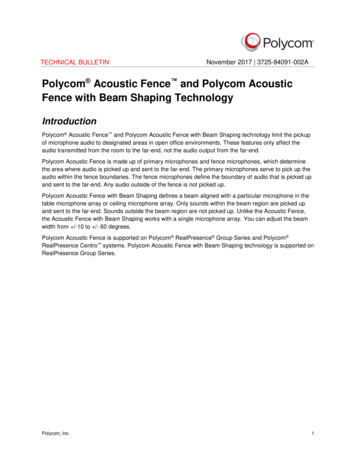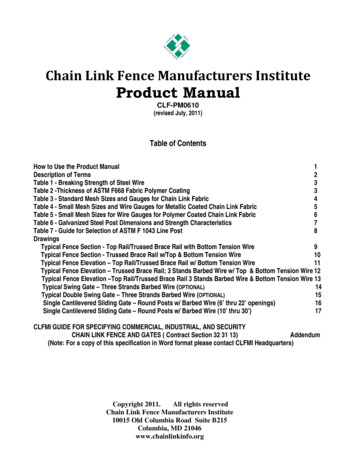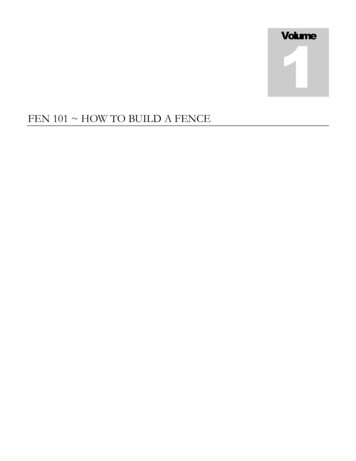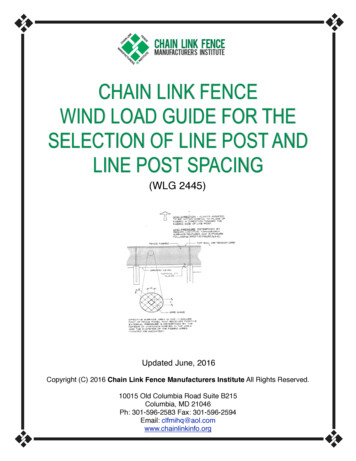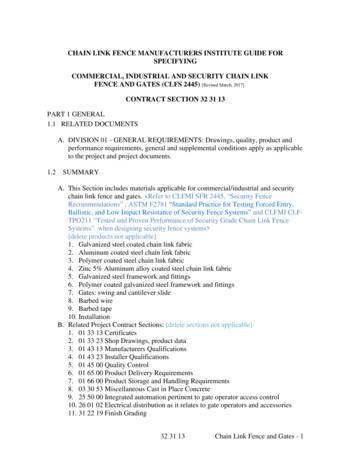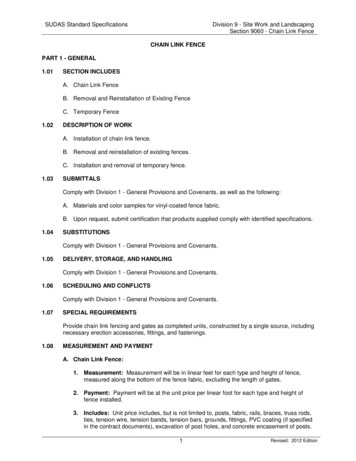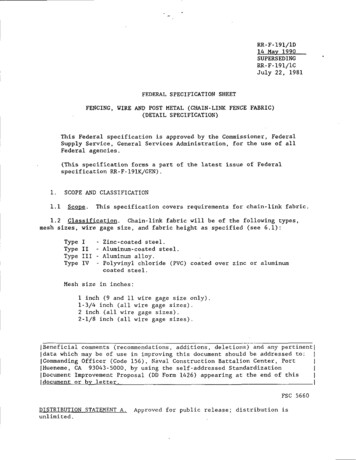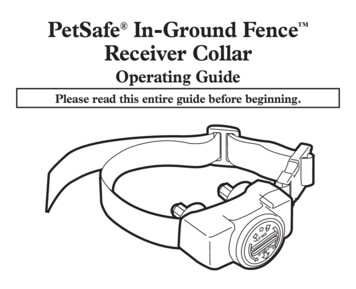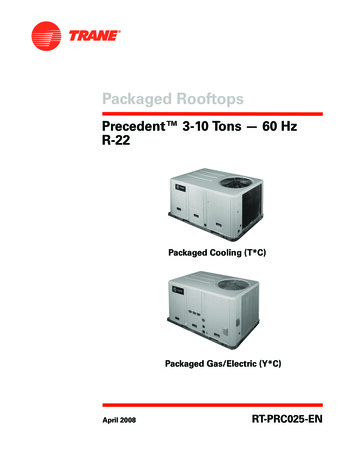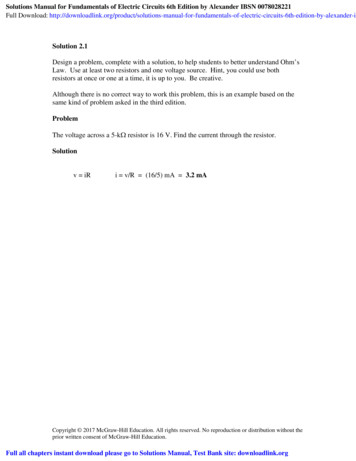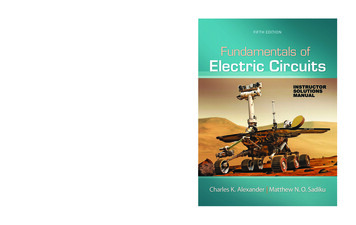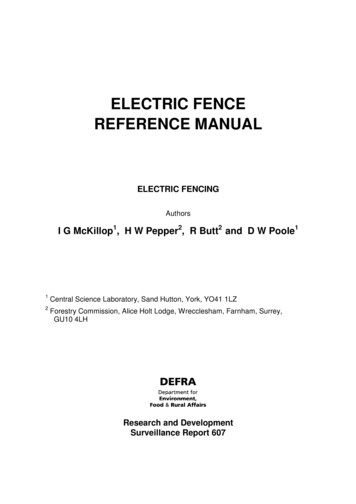
Transcription
ELECTRIC FENCEREFERENCE MANUALELECTRIC FENCINGAuthorsI G McKillop1, H W Pepper2, R Butt2 and D W Poole11Central Science Laboratory, Sand Hutton, York, YO41 1LZ2Forestry Commission, Alice Holt Lodge, Wrecclesham, Farnham, Surrey,GU10 4LHResearch and DevelopmentSurveillance Report 607
Electric Fence Reference porary or permanent?1Aims and Insulators and switches6Supporting posts10Conducting wire12Earthing13Fence testing withbatteryoperated15Batteries15Charging systems15Regulators16Fence specifications17Introduction17Encountering the fence for the first time17Principles of effective fence design19Specifications for domestic stock20Specifications for wild mammals22Safety aspects26Animal welfare26Human safety26Safety precautions27International and National Standards28Fence construction: techniques and best practice29Pre-construction work29Fence construction principles30Setting-up the energiser and charging system30Erecting the fence: posts, wires and insulators32Gates34Defra Research and Development Surveillance Report 607
Electric Fence Reference Manual67Fence siting36Planning aspects36Geography of the area36Ratio of length to area enclosed36Seasonal and climatic influences36Fence maintenance38Animal behaviour at fences38Implications of behaviour for the frequency of maintenance inspections38Fence inspections: when and what to check39Out-of-use fences40Appendix 1Defra Research and Development Surveillance Report 60741
Electric Fence Reference ManualINTRODUCTIONBackgroundAn electric fence usually consists of several conductors of bare wire, supported on insulatorsand connected to a fence energiser which in turn is connected to a power source and earthrod(s). Electric fences were first used in World War I to contain prisoners of war. Thesefences carried alternating current (a.c.) and were designed to kill anyone coming into contactwith them. It was not until the late 1930s that non-lethal fence energisers (also calledcontrollers or fencer units) producing direct current (d.c.) were developed to manage stock orwildlife. Nevertheless, these early energisers were still dangerous, unreliable and easily shortcircuited. Then, in the late 1930s, better units were developed, making the technique moresuccessful and acceptable.Over the last 30 years, improvements in energiser technology have continued to be made sothat now, in the early 2000s, a large range of energisers can be purchased. They arepowered either from a mains electricity supply or, where this is not available, by battery. Inremote areas, wind and solar power can be used to charge batteries. Energisers of varyingpower output, ranging from less than 1 joule to over 20 joules, can be purchased. (A joule (J)is the unit of energy used by manufacturers to specify the energy level of pulses produced bytheir products).Electricity flows as a result of electrical pressure which is measured in volts (V). Energisersproduce brief, high voltage pulses of electricity between the conducting wire and earth whenthe circuit is closed by animal contact. An animal standing on the ground and touching theelectrified wire completes the circuit and receives intermittent but regular shocks to deter it.The pulsed nature of the electricity enables animals to move away from the fence, sopreventing electrocution, although lethal fences still have a limited use in the Far East forcontrol of rodents.Temporary or permanent?The main value of electric fencing is as a temporary fence to contain stock or exclude wildlife.The relatively low cost of the labour and materials required to erect this type of fence, and itshigh adaptability compared with the equivalent requirements of a standard post and wirefence, makes it especially suitable for this purpose. For example, electric fencing enableslarge fields to be easily subdivided to allow their more efficient use by grazing stock.Electric fencing can also be used as a more permanent fence, particularly where failure wouldnot result in serious consequences. For example, it can be used in this way to keep stockaway from ditches, to control cattle in farmyards or to create access routes for cattle betweenmilking parlours and fields. It is, however, less suitable as a farm boundary fence where failurecould result in stock gaining access to neighbouring properties or roads.Aims and scopeTo obtain the maximum benefit from electric fencing, it has to be used safely and efficiently.The aim of this book is to provide guidance on how this can be done. The book is divided intoseven chapters. Chapter 1 provides information on fence energisers, insulators, conductingwire and earthing. Chapter 2 examines the compatibility of fence energisers, batteries andcharging systems. The third chapter provides guidance on appropriate fence specifications tomanage a range of domestic stock and wild mammals. Chapter 4 considers safety aspectsfrom the perspective of the user and humaneness from the perspective of the animal beingmanaged. The last three, Chapters 5, 6 and 7, look at fence construction, siting andmaintenance. Note that electric fencing used for security purposes around buildings to preventpotential criminal intrusion is not considered in this guide.Defra Research and Development Surveillance Report 6071
Electric Fence Reference ManualCHAPTER 1EquipmentThis chapter describes the range of fence components available and can be used as a guideto making choices when preparing a fence specification for a particular situation. Definitions ofthe terms used are given in Table 1. Many of them have synonyms or sometimes otherinterpretations which are used in different parts of the UK. The main components are shownin Figure 1 which outlines the principles and construction of an electric fence. Table 2 givesguidance on the suitability of the components for either temporary or permanent fencing.Figure 1ChargingSystemPrinciples of Electric FencingPowe Energiser andPowerearthing systemChargingSystemLead-inwire fromenergiserElectric FenceStrainingEarthedpostline wireMainsChargerorStakeInsulatorConductinglink wireStrutVoltageregulatorWindgeneratorand/orsolar panelPoweredconductingline ctrodeCross memberEarth return wireThrust plateFenceearthelectrodeCurrent pathCurrent flowKey:BBatteryM MainsEEnergiserCut-out switchIn-line insulatorPost insulatorWire stapleDefra Research and Development Surveillance Report 6072
Electric Fence Reference ManualTable 1 - Common electric fence terms and unitsTermsAlternating currentDirect currentDropperElectric fenceElectric animal fenceElectric fence energiserInsulatorLeakageLine wirePolythene wire (Polywire)Polythene tape (Polytape)PostShortStakeStrutAbbreviation a.c.Abbreviation d.c.A rigid vertical component used to keep line wires apart.A barrier which includes 1 or more electric conductors,insulated from earth, to which electric pulses are applied by anenergiser.An electric fence used to contain animals within or excludeanimals from a particular area.An apparatus which is intended periodically to deliver voltageimpulses to a fence connected to it.A non-conductive material or a device made with the intentionof preventing current flow.A small energy loss from the fence line to earth.A single fence wire, which may be either single strand ormulti-strand.Polypropylene or Polyethylene twine incorporating one ormore stainless steel or tinned copper strand(s).Polypropylene or Polyethylene woven tape incorporatingstainless steel or tinned copper strands.Posts are placed in a hole dug in the ground and firmed. Theymay be used as:1. a straining post to tension line wires to and from;2. a contour post to hold a fence in depression or valley;3. a turning post when the fence line changes direction andthe internal angle is greater than 110 .A large energy loss from the fence line to earth.A post that is driven into the ground.An angled support to a straining post.UnitsAmpereJouleOhmVoltA unit of electrical rate of current flow. SI unit symbol: AA unit of electrical energy. SI unit symbol: JA unit of electrical resistance. Symbol: ΩA unit of electrical pressure. SI unit symbol: VDefra Research and Development Surveillance Report 6073
Electric Fence Reference ManualTable 2 - Electric fence component er (mains powered)!!Energiser (battery powered)!!!!Battery charging system (wind solar)!!Battery charging from mainsNon-rechargeable battery!Straining post - wood!!!!!!!Contour post - woodTurning post - wood!!!Strut - wood!!!Stake - wood, plastic, metal or fibreglass!!!!Insulators integral with stake!!!!Porcelain insulators!!Plastic insulators!!Tube insulators!!Off-set insulators!!1.6 mm and 2.00 mm medium-tensile steel and aluminium wire!!!!2.5 mm high-tensile, 2.65 spring-steel and 3.15 mm mild steel wireMulti-strand steel cable!!!Polythene and stainless steel wire ‘Polywire’ and ‘Polytape’!!!Polywire electric mesh netting!!Barbed wire/meshxxxxCopper coated steel earth rod!!!!!Zinc coated steel earth rodaTemporary fences are considered to be those required for less than 3 years.! occasional use!! principle useDefra Research and Development Surveillance Report 607xx not to be used4
Electric Fence Reference ManualIntroductionThe objective of any electric fence must be clearly defined before any consideration is given toits detailed specification and certainly before any construction is begun. Therefore knowledgeis required about:1. The species and sometimes breed of animal which is to be managed and its capability toscale, burrow or just force its way through a fence.2. The pressure on the fence which is related to the number of animals on one side of thefence and their need to be on the other side.3. The length of time an effective fence is required.4. The maximum permitted level of financial expenditure.Electric fencing, to be effective, must have its conducting wires totally insulated and effectivelyisolated from the ground. The fence structure must be of sufficient strength and capacity todeliver an electric shock sensation to an animal when touched.If an animal is to receive an effective shock upon contact with the bare electrified fence wire,current must be able to flow through its body to the ground. This can only happen byestablishing a very sound earthing area system which must be connected directly to theenergiser. The degree of shock sensation experienced is directly related to the level of thecurrent which can pass through the animal’s body and the time it takes to do so: the higher thecurrent and the longer it takes to pass through, the greater the shock sensation. Current levelis regulated by electrical resistance which opposes the flow of current: the higher theresistance the lower the current and the less the shock sensation experienced. A goodearthing system will help to minimise resistance, but current flow will still be affected by theresistance between those parts of the animal’s body which come in contact with the fence andwith the ground and by the resistance of the ground itself. A higher level of voltage producedby the energiser will help to overcome a high resistance path through the body, but will be oflittle consequence if the earthing system is not soundly constructed.EnergisersThe centre of any electric fence system is the energiser. There are two types: mains operatedand battery operated. The energiser converts a.c. or d.c. voltage, respectively, into repetitivehigh voltage pulses of d.c. voltage which are delivered along the entire length of a fenceconnected to it. Each pulse lasts for a very short time (approximately 500 microseconds) andis produced at one second intervals. Thus, fence energisers are constantly switching on andoff, and it is this characteristic which is responsible for preventing a fatality under normaloperating conditions. The voltage peak of each consecutive pulse can rise to a limit of 10,000V; values exceeding this limit are considered unsafe by present international safetystandards.Voltage is not the only aspect to be taken into consideration where safety is concerned. Eachpulse will contain a potential quantity of electrical energy. This quantity of electrical energy ismeasured in joules (J). Energisers with an output in excess of 5 J are not recommendedunder UK Health and Safety codes of practice, although those producing up to 20 J arenevertheless available on the market.Each of the mains operated and battery operated energisers are sub-divided into the twocategories of high or low power. Many of the energisers available allow the choice of eitherlow or high energy outputs. These outputs are usually available from colour coded terminalson the energiser. A red coloured terminal will usually identify the higher output and a yellowcoloured terminal the lower output. The earth terminal, common to either output, is green.The most recent designs of energisers have digital liquid crystal display providing certaincharacteristics of the output on the fence, such as fence voltage and earth leakage.There are three important factors to be considered when choosing an energiser: fence location animals to be controlledDefra Research and Development Surveillance Report 6075
Electric Fence Reference Manual fence length.Under most circumstances, fence location will dictate the selection between a mains or batterypowered energiser. For example, in remote areas where no mains supply is available, the onlyoption will be a battery powered unit. When a battery powered energiser is selected,consideration must be given to replacing or recharging the battery which, with a higherpowered energiser, may be as frequently as every two weeks. Thus, where there is a choice,mains operated energisers are preferable to avoid the problems of battery charging andmaintenance.Differe
Animal behaviour at fences 38 Implications of behaviour for the frequency of maintenance inspections 38 Fence inspections: when and what to check 39 Out-of-use fences 40 Appendix 1 41. Electric Fence Reference Manual Defra Research and Development Surveillance Report 607 1 INTRODUCTION Background An electric fence usually consists of several conductors of bare wire, supported on File Size: 272KBPage Count: 41
